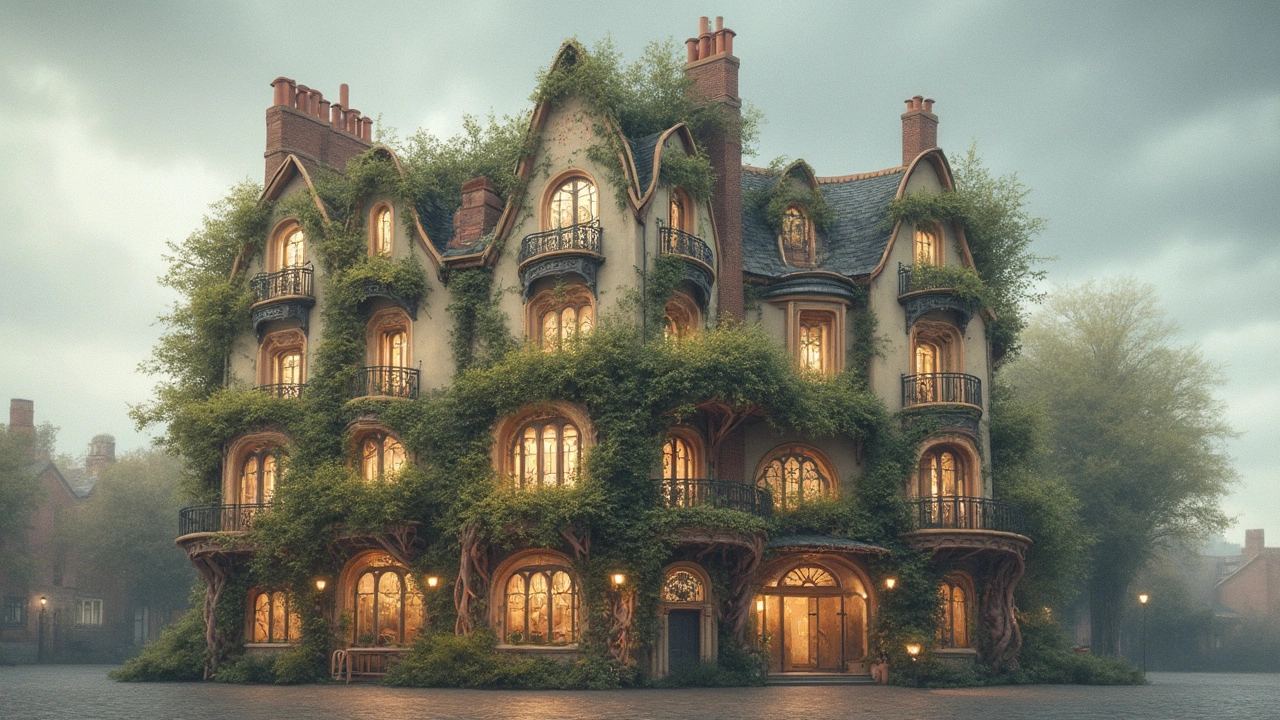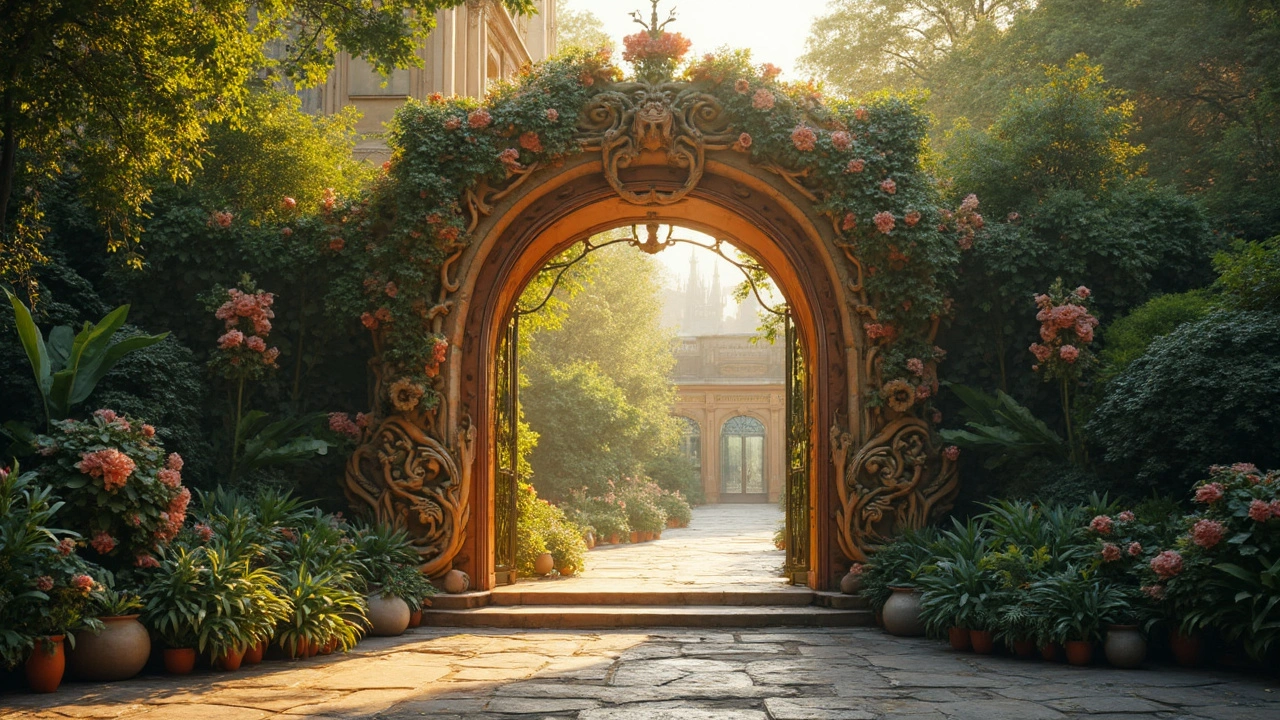Art Nouveau Architecture: The Epitome of Elegance
 Feb, 22 2025
Feb, 22 2025
Art Nouveau architecture is like stepping into a daydream, with its swirling shapes and nature-inspired designs. If you're wandering through a city and spot an intricate iron balcony with flower motifs, chances are, you've stumbled across a piece of this charming style. It first took off in the late 19th century as a kind of protest against the rigid, impersonal lines of the industrial era, opting instead for curves and detail that mimic the beauty of nature.
But what exactly makes a building 'Art Nouveau'? Picture elegant facades that seem to flow like water, often adorned with floral and vine patterns. Look for curvy lines—they create movement even in stillness. Stain glass windows might shimmer with all the colors of the rainbow, casting a mystical glow indoors. And don't forget the wrought iron: it often bends into intricate designs, sometimes even mimicking vines and flowers.
- Origins of Art Nouveau
- Key Features and Elements
- Famous Art Nouveau Architects
- Tips for Identifying Art Nouveau Buildings
Origins of Art Nouveau
The roots of Art Nouveau can be traced back to the late 19th century, during a time when artists were itching to break away from the past. Imagine being surrounded by industrial drabness and longing for something more lively and, well, human. That’s where this style found its groove.
Emerging mostly in Europe, places like France, Belgium, and Spain were the main breeding grounds for this fresh, new look. It's no coincidence that 'Art Nouveau' means 'New Art' in French—these architects wanted to redefine what architecture could be.
Early Influences and Key Ideas
Art Nouveau took a lot from nature; it’s like these artists were on first-name terms with trees and flowers. Curved lines inspired by plants and flowers became a signature of the style. It was all about harmony between nature and architecture, giving buildings character and soul.
But why did it happen at this time? Well, society was going through massive changes, with the Industrial Revolution making everything fast and, quite frankly, a little too straight-laced for some tastes. Art Nouveau stepped in with its ornate decorations as a breath of fresh air.
Pioneers of the Movement
Names like Victor Horta and Antoni Gaudí might sound familiar. They were the trailblazers who pushed Art Nouveau into the limelight. Horta, especially in Brussels, crafted buildings where even the staircases had swagger. Gaudí's whimsical style in Barcelona continues to wow visitors with buildings like the famous Sagrada Familia.
| Architect | Country | Notable Works |
|---|---|---|
| Victor Horta | Belgium | Hôtel Tassel, Hôtel Solvay |
| Antoni Gaudí | Spain | Sagrada Familia, Casa Batlló |
Hope this gives you a clearer idea of how Art Nouveau started to change the world, one elegant curve at a time.
Key Features and Elements
Diving into the world of Art Nouveau architecture, it's like finding treasure hidden in plain sight. One key feature you can’t miss is the fluid, curvy lines that seem to ripple across buildings. These curves break away from traditional straight lines, bringing an organic feel to the structures. They represent the movement and flexibility of nature which was a huge influence for designers back then.
Another hallmark is the use of floral and animal forms. Think of petals and leaves wrapping around balconies, or birds seamlessly integrated into the facade. This connection to nature wasn't just decorative; it was a philosophy of blending human living spaces with the natural environment.
Decorative Glass
Stained glass windows are a staple in Art Nouveau and are truly remarkable. These colorful additions don’t just look pretty; they play with light in fascinating ways, often casting colorful shadows into the interior. This isn’t just art for art’s sake—it’s about enhancing the living experience.
Wrought Iron Details
Now, let’s talk ironwork. You’ll find fantastically detailed iron elements on banisters, balconies, and gates. Look out for twisting vines and delicate leaf patterns fashioned from metal. These aren’t just for show; they underline the craftsmanship and attention to detail that make Art Nouveau stand out.
Ornamentation
Perhaps one of the loveliest features is the generous use of ornamentation, such as mosaics and ceramics. Facades are often a collage of colors and textures, adding depth and complexity to the buildings.
If you’ve ever walked past a building and it seemed to whisper stories of a time when design met nature halfway, chances are you’re looking at Art Nouveau architecture. Recognizing these elements is not just about appreciating a building; it’s about seeing the meeting point of art, craft, and function.

Famous Art Nouveau Architects
When you think about Art Nouveau architecture, it's hard not to mention some of the giants who truly defined this elegant style. These are the folks who turned buildings into works of art. Let's dive into a few names you'll want to remember.
Antoni Gaudí
First up, you have Antoni Gaudí, the mastermind behind some of Barcelona’s most eye-catching buildings. Think of his masterpiece, the Sagrada Familia, which even today isn't fully finished. Gaudí loved to play with shapes and colors, bringing a whole new level of dynamism to architecture design. His Casa Batlló, with its skeletal facade and dragon's back roofline, is a perfect example of how he merged art with architecture.
"Nothing is art if it does not come from nature." — Antoni Gaudí
Hector Guimard
Then there's Hector Guimard, the French architect mainly known for the entrance designs of the Paris Metro. His use of curvy lines and organic forms made ordinary subway entrances something out of a fairytale. These entrances are emblematic of the Art Nouveau movement in Paris and continue to charm both Parisians and tourists alike.
Victor Horta
In Belgium, Victor Horta was a leading figure in the Art Nouveau wave. With buildings like Hotel Tassel in Brussels, Horta set the standard for integrating architecture with interior design. His use of light, as well as the open floor plan, were ahead of his time, proving that functionality and beauty could coexist.
These architects did more than just design—they reimagined what a building could be. If you ever find yourself strolling through cities like Barcelona, Paris, or Brussels, keep an eye out for these iconic structures. Not just because they're famous, but because they truly capture the essence of elegance and design.
Tips for Identifying Art Nouveau Buildings
So, you're out exploring and want to spot some Art Nouveau treasures? It's easier than you might think once you know what to look for.
Embrace the Curves
The biggest giveaway is the use of curves. Unlike the sharp angles found in other architectural styles, Art Nouveau is all about sweeping, organic lines. Look for buildings that seem to flow or have facades with wavy, undulating features.
Floral and Nature Motifs
Art Nouveau architects loved integrating nature. Common motifs include flowers, vines, and even peacocks. If a building is decked out with these elements, you're likely gazing at an Art Nouveau gem.
Stained Glass
Many Art Nouveau buildings feature stunning stained glass windows. These aren’t just functional—they’re works of art, often displaying vibrant colors and intricate designs. Keep your eyes peeled for these when stepping inside or looking up at windows.
Ironwork Details
Decorative ironwork is another hallmark. Think ornate balconies or gates that look like they could be part of a botanical garden, with lots of curves and nature-inspired designs. These details often showcase the craftsmanship that Art Nouveau celebrated.
Materials Matter
This style also favored certain materials, like ceramic tiles and glass. These helped achieve the smooth, flowing surfaces typical of Art Nouveau architecture. It's not just about the structure but the textures and appearances too.
| Feature | Description |
|---|---|
| Curved Lines | Sweeping, organic curves often in facades. |
| Floral Motifs | Inspired by natural forms, especially flowers. |
| Stained Glass | Vibrant, artistic glass installations. |
| Ironwork | Intricate metal designs, often resembling vines. |
| Materials | Use of ceramic tiles, glass, and iron for texture. |
The next time you're wandering around places known for historical architecture, like parts of Europe or even certain parts of the US, see if you can spot these clues. Happy hunting!